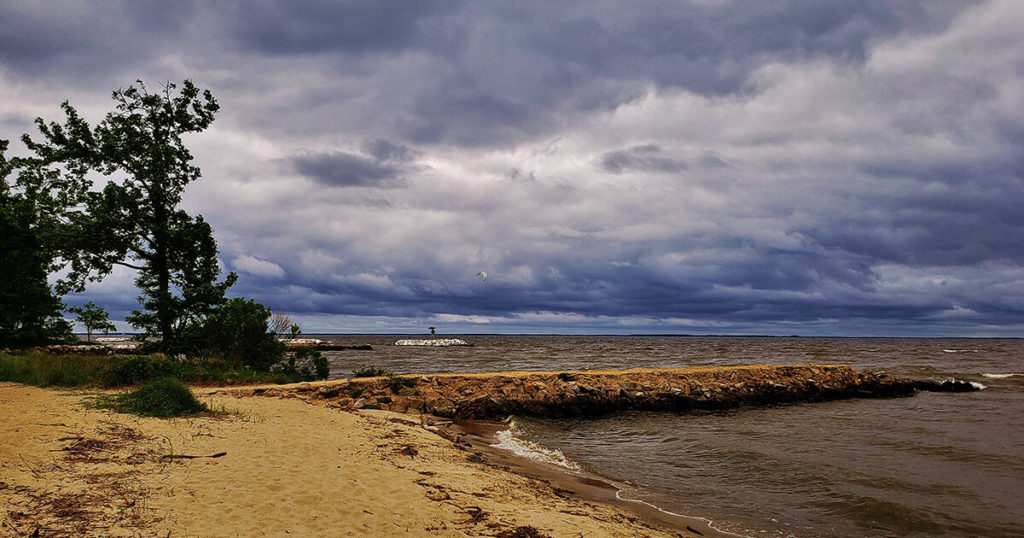Trouble on the Chesapeake
A new proposal to clean up the bay raises old questions for environmental reformers

Should the Chesapeake Bay, a formidable force in the natural and economic well-being of the six states it washes, have “bubble curtains” rising from submerged tubes beneath 80 miles of one of the country’s most important waterways?
The question arises from a notion—it can’t yet be called a plan—to add oxygen to the water, thereby counteracting the algal dead zone that develops in the middle of the bay every summer. But the answer raises further cultural, aesthetic, and environmental questions, as well as a growing feeling among the vast community of scientists and activists who care about such subjects that they are no longer purely secular. Many believe that the preservation of extant species is the greatest imperative when cleaning up the bay; others argue that all options should be pursued, even if they involve picking and choosing among beneficiaries. The debate over how to save the Chesapeake loops in legions of defenders and exploiters and all the ideological shadings in between, highlighting the prolonged biological cliff-hanger that is the Anthropocene.
The issue began when a veteran water resources consultant named Dan Sheer, who has studied the Chesapeake’s dead zone closely, wondered if bubbles might alleviate the effects of pollution in the bay. In his scheme, the tiny bubbles would rise from 16 pipes placed at five-mile intervals. They could be serviced by discreet structures on shore, or from anchored barges. The Chesapeake is broad and crossed daily by much bigger shipping vessels, so in theory, the generators and barges wouldn’t be that intrusive.
The estimated cost of installation ranges from $10 to $20 million, with an additional $11 million annually for maintenance. A coalition of the six Chesapeake Bay watershed states, plus the federal government, spent $2 billion in fiscal year 2017 cleaning up the bay, with real improvement in water quality and species regeneration. The algal problem, though, remains at unacceptable levels.
The cost of trial bubble curtains on a small scale would be, Sheer estimates, only $2 million, which would have to come from donations. “If it works it could also help other parts of the bay, including the oyster beds,” he told me. “And we would get a lot of valuable new data.”
There are few easy answers to the environmental questions, a cautious note that opponents of the bubble curtains have been quick to strike. Examples abound of disasters resulting from faulty quick fixes, like the U.S. Army Corps of Engineers’ continuing assaults on rivers or the midcentury poisoning of an entire food chain with DDT. Extreme care is therefore required to avoid unintended consequences.
Objections by scientists and activists to artificially oxygenizing the bay are broad but boil down to four main points: The bubbles could disturb fish and microorganisms, as well as submerged soils that might release greenhouse gases and heavy metals if moved. The bubble generators would also clutter the natural landscape, undermining incentives for agriculture and homeowners to stop pol-luting with industrial waste and fertilizer, deplete funds for more urgent mainstream research, and offend aesthetic and moral sensibilities.
“This is the second or third time this idea has come up,” Beth McGee, a director of science and agricultural policy at the Chesapeake Bay Foundation, told me. In an article for the Bay Journal, she also echoed the general fears about the bubble curtains, saying that she thinks the project “a horrible idea” from a policy perspective.
Her focus remains on reducing pollution in the bay, which has many sources, but washes down in great quantities through the Susquehanna River, the bay’s main tributary. “The larger issue all over the bay is improved water quality,” she notes. Light falling through clearer water means more grass growing on the bay floor, which means more aquatic life. Last year there was more abundant grass than at any time since the 1980s—a considerable achievement—but the bay is still a mess when compared to what it once was.
I asked McGee if the bubble curtain debate is an example of the perfect being the enemy of the good. She said emphatically not. “We’re always open to new ideas for a better, faster, cheaper way to clean up America’s largest estuary,” she said. “Bubbles would be a distraction from that larger purpose.”

